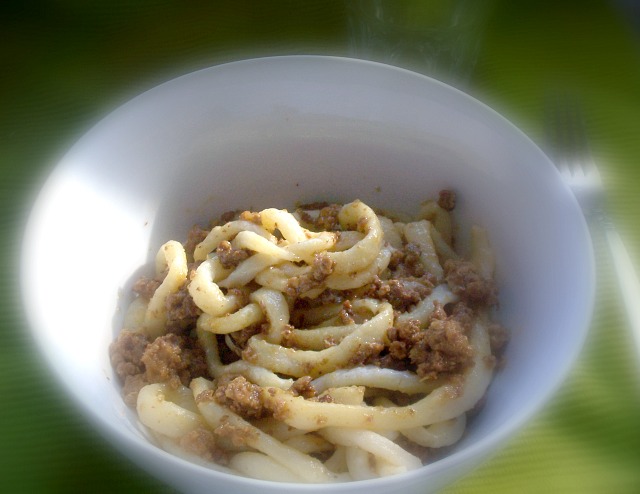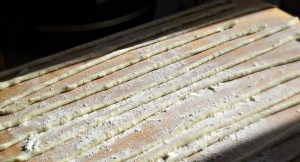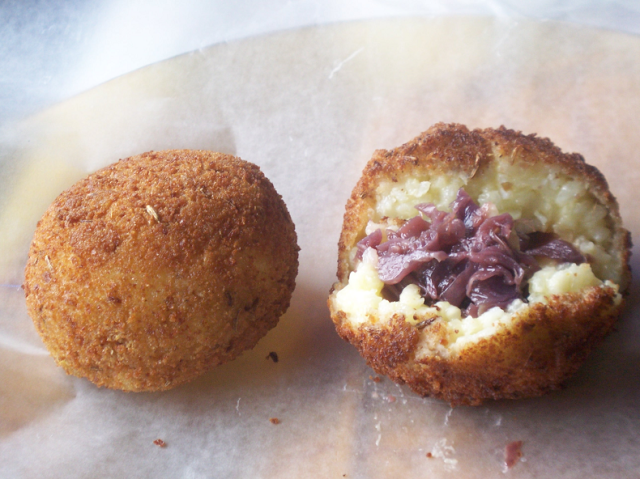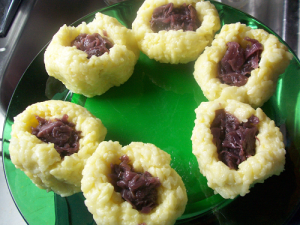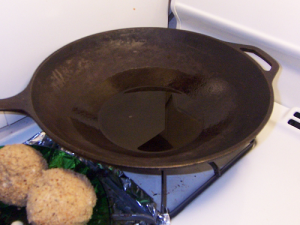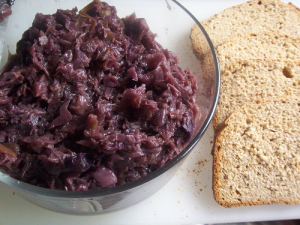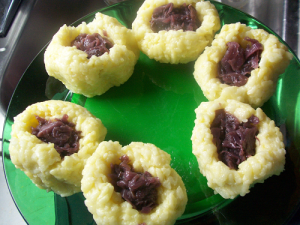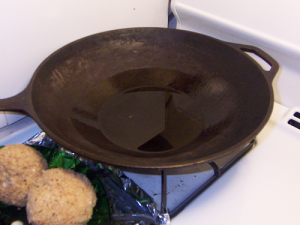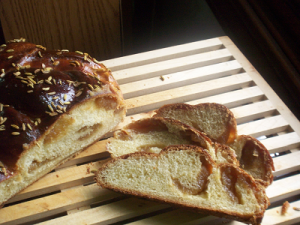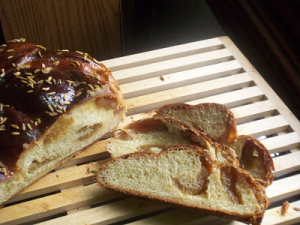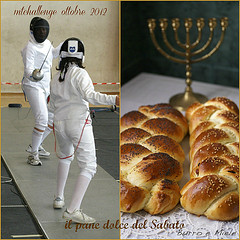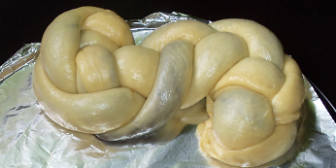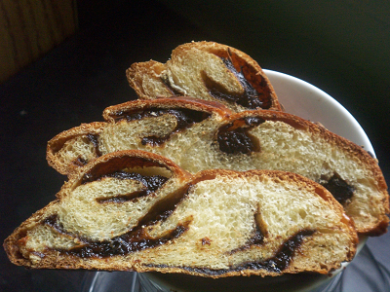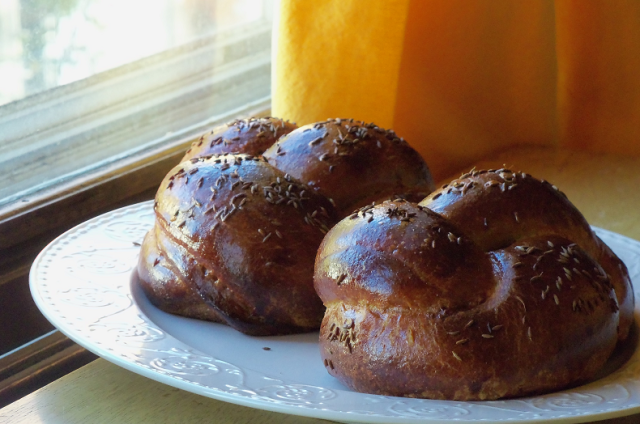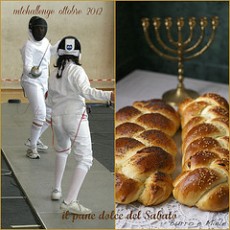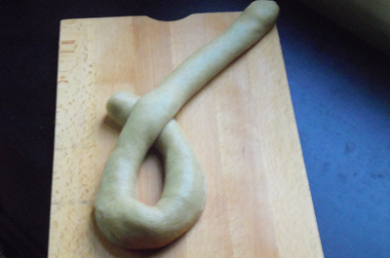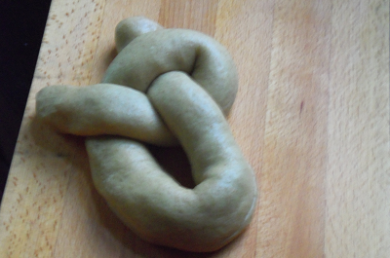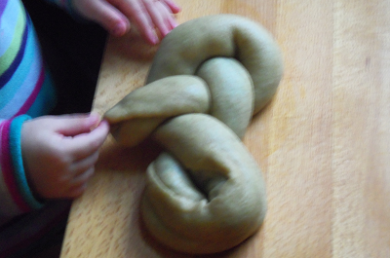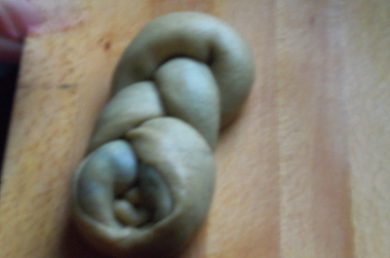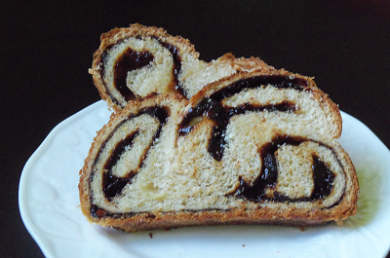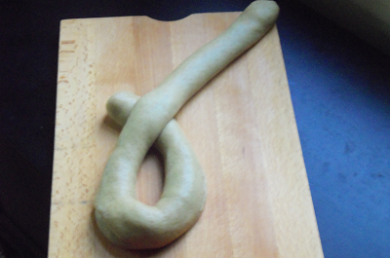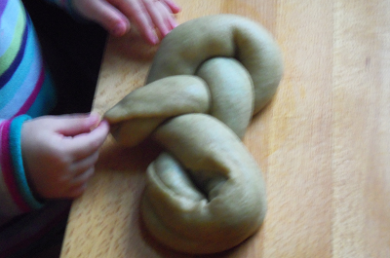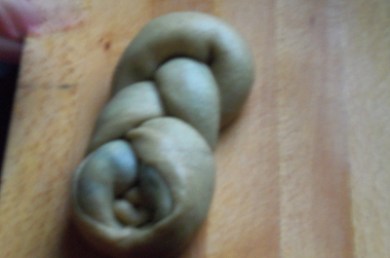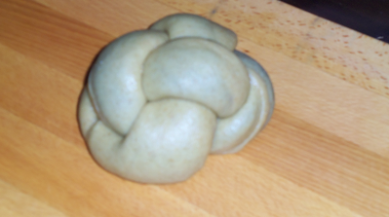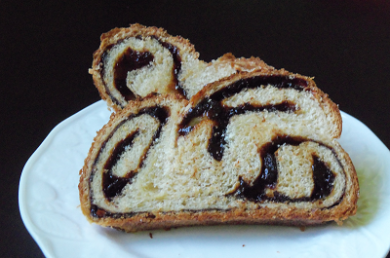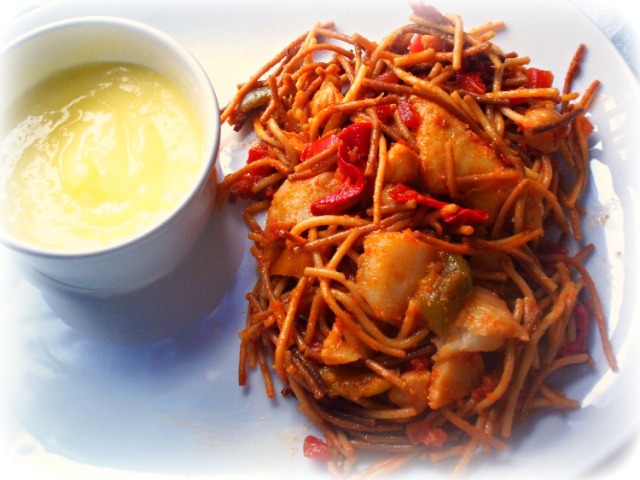

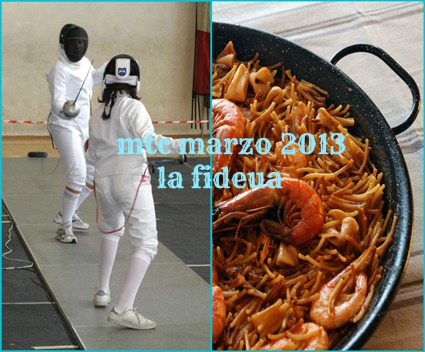
Traduzione italiana in fondo
Mai, who won the MTC last month, chose Fideuà a dish from her homeland (Valencia) for us to make this time. By the way, this is the fifth challenge I participate in since my joining the MTC team. Which means I am midway to completing the required 8-challenges minimum expected of all participants. I am really glad to be part of this. I was welcomed so warmly in the group, and they are all so talented both in front of the stove and behind the camera that I always wonder how can I be a member. But they are also very nice people and make you feel like you belong and that they are actually happy that you do.
I have never had or even known about this dish, but the name was strangely familiar. As it turns out, it consists of a mix of fish and shellfish and thin pasta strands called fideos, similar to vermicelli or angel hair, cooked together in a fish stock, saffron, and tomato base. The final dish is served with a garlicky sauce on the side.
The name was familiar to me, indeed, because it is almost the same as a very old Sephardi dish, fideos tostados, a much simpler—and kosher—version made only with pasta, onions, and tomatoes. The technique is the same, in fact—the pasta is first toasted in a little olive oil and then cooked in just enough liquid so that the final result is not soupy at all. My Italian friends will probably cringe knowing that we do not cook our fideos al dente, but just a little softer, even if not mushy. The Sephardic fideyos predate the discovery of America and at first did not contain tomatoes; sometimes they were served dressed with olive oil and lemon juice, or cheese, or added to soups and stews, especially for Shabbat. The relatively more recent tomato-y version has become the most popular, despite being so simple and homey. It is traditionally served at the meal preceding the fast of Yom Kippur.
In fact, this particular dish for the MT Challenge reminded me of my grandma’s fideos, which she would cook for me every time I visited, as it was my absolute favorite. Even now, that is a dish that to me is truly comfort food, as it evokes affection, care, and family ties that are stronger than time and distance.
But it also evoked memories of family lore, so far away in time and space to become almost legend—at least in my eyes. My great-great-grandmother Anna descended from a Sephardi family that left Spain following the Jewish Expulsion in 1492. They were from Gerona, in Catalonia, where once a great Jewish community flourished and produced an important Kabbalistic school.
I have, of course, never met her, but her (only) daughter, my great-grandmother, used to say I looked a lot like her, and after her I was named.
So, in honor of my great-great-grandma Anna, I decided that I would make a kosher version of this dish, and use ingredients that somehow relate to the Sephardi heritage. I chose chickpeas, sweet peppers, and fresh cod. I know Mai requested that we use simple foods that would be available on a fishing boat, and I wondered whether bell peppers would qualify. Then it occurred to me that if fresh tomatoes were actually required, then fresh peppers might as well be OK.
The original recipe also includes garlic, both in the pasta and in the accompanying sauce. That was impossible for me, since garlic makes me very, very ill for many days if I eat some—not that I ever want to. My family likes it though, and since it is in general a very healthy food, I normally prepare garlicky dishes just for them. But this time I wanted us all to share the same dish, and used only onions. For the accompanying sauce, I had no hesitations; it would be Agristada. It is a very old Sephardi recipe that originally was made with agresto, or sour grapes juice. As that ingredient was not always easily available, it was replaced by fresh lemon juice in Medieval times. The sauce can be made with fish, vegetable or meat stock, or even just with water, depending on the nature of the food it will be used with. Most often, it is paired with fried fish, but for Passover it is also eaten with boiled artichokes. The Italkim (Italian Jews) know it as Bagna Brusca, and use it to dress tagliatelle to eat cold for Shabbat. Greek avgolemono is similar but soupier. Agristada can be served warm or cold. Sometimes, a little extra-virgin olive oil is added to it, and served cold is similar to mayo–minus the potential issues associated to consuming raw eggs).
For the fish stock, I used a prepackaged mix of fish parts that my local kosher fishmonger offers just for that purpose. Fresh cod fillets were my fish of choice, since I did not want to use freshwater fish this time. It is imperative to use dried chickpeas, as their cooking liquid is used to complement the fish stock. Besides, canned chickpeas are too mushy to begin with and would disintegrate in the final dish. I did not use any spices but a couple of bay leaves for the chickpeas.
Fish Stock
2 lb kosher fish parts (heads and bones)
10 cups water (or as needed)
1 onion
1 carrot
1 stalk celery
1 bunch of parsley
10 grains of pepper
1 tbsp kosher salt
Place the fish parts and the vegetables (washed and sliced) together with the parsley, pepper, and salt in a large pot. Add water just to cover, bring to a boil, then simmer for about 30 minutes. Strain.
Chickpeas
1 lb dried chickpeas (soaked overnight in cold water, then drained and rinsed)
1 fresh tomato
2 bay leaves
1 onion
salt
Slice the onion, peel the tomato, eliminating the seeds, and dice finely. Place the soaked chickpeas and the prepared vegetables in a pot and add enough cold water to cover everything by 2 inches. Bring to a boil, then simmer,covered, until the chickpeas are tender, adding salt to taste towards the end of the cooking time. You will have a lot of chickpeas, more than you need for this dish, but they can be frozen with some of their liquid).
Agristada Sauce
1 cup fish stock (strained)
2 large eggs
1/2 tbsp cornstarch
1/3 cup freshly squeezed lemon juice
salt to taste
Put all ingredients in a blender and mix briefly (or place everything in a pan and blend with an immersion blender). Cook on medium heat, stirring constantly for about 3 minutes, until thickened. Do not boil. Taste and add more salt if needed. Keep covered in a glass container and serve warm or cold (refrigerate any leftovers promptly).
Fideuà
1 lb fideos or spaghetti, broken into 1-inch. pieces
2 fresh tomatoes, peeled and finely diced
1 onion, finely diced
1 lb wild Alaskan cod fillets cut in 2 x 2 -inch pieces
3 bell peppers (1 green, 1 yellow, 1 red), cut in strips
2 cups of cooked chickpeas, drained (save the liquid!)
fish stock (strained) as needed
chickpeas cooking liquid (strained) as needed
salt to taste
extra-virgin olive oil
Heat 2 tbsp olive in a large cast-iron pan and lightly toast the pasta, stirring, taking care not to burn it. Put the pasta on a platter and in the same pan add 1 more tbsp olive oil, then briefly cook the fish, just until it begins to flake. Place the cooked fish in a covered container to keep it warm. Add the onion to the pan and saute until soft and transparent, then add the tomatoes and peppers, sauteing until the peppers are soft and the tomatoes begin to turn jammy. Add salt to taste and add a few tbsp of fish stock. Finally, add some fish stock and some chickpeas cooking liquid, enough to cover the fideos once they are returned to the pan. As soon as the liquid begins to boil, add the toasted fideos and cook, stirring, for half the pasta’s required cooking time—my fideos cooked for a total of 10 minutes. At that point add the cooked fish and chickpeas and continue cooking, stirring, until the pasta is ready. (You might need to add a little more cooking liquid to cook the pasta, but careful not to turn it into a soup).
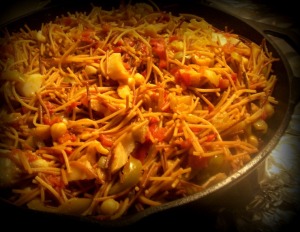
The Agristada paired extremely well with this dish, its tangy and refreshing taste truly complemented the fish and vegetables that dressed the pasta. This was the last pasta and legumes I cooked before preparing the house for Passover, which requires eliminating all sources of Chametz. We all enjoyed it and it will likely become part of our routine, because it makes for a very tasty and nutritious one-pot meal.
Thank you Mai for this recipe, and thank you Ale, Dani and Giorgia for MTC!!!
Traduzione italiana
Mai, che ha vinto l’MTC del mese scorso, ha proposto la Fideuà, un piatto della sua terra d’origine (Valencia) per la sfida di questo mese. A proposito, questa è la quinta sfida a cui partecipo da quando sono entrata a far parte dell’MTC. Il che significa che sono a metà strada per completare il numero minimo di otto sfide come da regolamento. Sono davvero felice di farne parte. Sono stata accolta così calorosamente nel gruppo, in cui tutti hanno un grande talento sia in cucina che con la macchina fotografica, che mi chiedo sempre come faccia io a farne parte. Ma sono anche persone molto gentili e ti fanno sentire che gli fa anche piacere che tu faccia parte del gruppo.
Non avevo mai saputo (o assaggiato) di questo piatto, ma il nome mi era stranamente familiare. Come ho visto, si tratta di pesci e frutti di mare con un tipo di pasta chiamata fideos, simile ai vermicelli o capellini, cotti insieme in un brodo di pesce, zafferano, e pomodoro. Il piatto finale è servito con una salsa all’ aglio.
Il nome mi era familiare, certo, perché è quasi lo stesso di un piatto molto antico degli Ebrei Sefarditi, chiamato fideos tostados, molto più semplice e kosher, fatta solo con la stessa pasta, cipolle e pomodori. La tecnica è uguale, infatti, la pasta viene prima tostata in poco olio e poi cotta in liquido appena sufficiente da ottenere alla fine un piatto asciutto, non brodoso. I miei amici italiani probabilmente rabbrividiranno nel sapere che non cuciniamo i nostri fideos al dente, ma un po’ oltre. I fideyos sefarditi sono anteriori alla scoperta dell’America e in un primo momento non contenevano pomodori, a volte erano serviti conditi con olio d’oliva e succo di limone, o formaggio, o aggiunti a zuppe e stufati, soprattutto per lo Shabbat. La versione relativamente piu’ recente col pomodoro comunque è diventata la più popolare, nonostante sia un piatto molto semplice, da famiglia. E’ servito tradizionalmente per il pasto che precede il digiuno di Yom Kippur.
In realtà, questo piatto particolare per la sfida di MT mi ha ricordato i fideos tostados di mia nonna, che lei cucinava per me ogni volta che andavo a trovarla, essendo il mio preferito in assoluto. Oggi piu’ di allora, per me è veramente un cibo consolatorio, in quanto evoca l’affetto, la cura, e i legami familiari che sono più forti del tempo e della distanza.
Ma ha anche evocato ricordi della mia tradizione familiare, così lontano nel tempo e nello spazio dar diventare quasi leggenda — almeno ai miei occhi. La mia bis-bis-nonna Anna discendeva da una famiglia sefardita che abbandono’ la Spagna dopo l‘editto di espulsione ebraica nel 1492. Erano originari proprio di Gerona, in Catalogna, dove un tempo fiorì una grande comunità ebraica che diede vita ad una importante scuola cabbalistica.
Ovviamente, non ho mai conosciuto la mia bis-bis-nonna, ma la sua (unica) figlia, la mia bisnonna, diceva che le assomigliavo moltissimo, e porto il suo nome.
Così, in onore della mia bis-bis-nonna Anna, ho deciso che avrei fatto una versione kosher di questo piatto, utilizzando ingredienti che in qualche modo si riferiscono al patrimonio culinario sefardita. Ho scelto ceci, peperoni e merluzzo fresco. Mai ha richiesto che usassimo ingrededienti semplici, che potrebbero essere facilmente disponibili nella cambusa di un peschereccio, e mi chiedevo se i peperoni freschi fossero accettabili. Poi mi e’ venuto in mente che, se i pomodori freschi erano necessari, i peperoni freschi dovevano andare altrettanto bene.
La ricetta originale comprende anche aglio, sia nella pasta che nella salsa di accompagnamento. Era impossibile per me, dal momento che l’aglio mi fa stare molto, molto male per molti giorni se ne mangio anche solo un po’ —non che ne abbia mai il desiderio. Alla mia famiglia piace, però, e dato che è, in generale, un alimento molto sano, io di solito preparo piatti con aglio solo per loro. Ma questa volta ho voluto che tutti noi condividessimo lo stesso piatto, e ho utilizzato soltanto cipolle. Per la salsa di accompagnamento, non ho avuto esitazioni, sarebbe stata l’ Agristada. E ‘una ricetta molto antica sefardita che originariamente era fatta con l’ agresto, o succo d’uva acerba. Poiché tale ingrediente non era sempre facilmente disponibile, fu sostituito da succo di limone fresco in epoca medioevale. La salsa può essere fatta con brodo di pesce, vegetale o di carne, o anche solo con acqua, a seconda del cibo che dovra’ accompagnare. Il più delle volte, si serve con pesce fritto, ma per la Pasqua ebraica è anche mangiata con carciofi bolliti. Gli Italkim (ebrei italiani) la conoscono come Bagna Brusca, e la usano per condire le tagliatelle da mangiare fredde per lo Shabbat. L’ Avgolemono greco è simile ma piu’ liquido. L’ Agristada può essere servita calda o fredda. A volte, se e’ servita fredda viene preparata con l’aggiunta di un po’ di olio extra-vergine di oliva, e il risultato finale e’ simile alla maionese (ma eliminando il problema dell’uovo crudo).
Per il brodo di pesce, io ho usato un mix preconfezionato di parti di pesce che il mio pescivendolo kosher locale offre prprio per questo scopo. I filetti di merluzzo freschi sono stati la mia scelta, dal momento che non volevo usare pesci d’acqua dolce questa volta. E ‘indispensabile utilizzare ceci secchi, siccome il loro liquido di cottura viene utilizzato per integrare il brodo di pesce. Inoltre, i ceci in scatola sono troppo morbidi per cominciare e si sarebbero disintegrati nel piatto finale. Non ho usato le spezie, ma un paio di foglie di alloro per i ceci.
Fumetto di Pesce
1 kg di parti di pesce kosher (teste e lische)
2,5 l dii acqua (o secondo necessità)
1 cipolla
1 carota
1 gambo di sedano
1 mazzetto di prezzemolo
10 grani di pepe
1 cucchiaio di sale kosher
Mettere i pezzi di pesce e le verdure (lavate e affettate) insieme con il prezzemolo, il pepe e il sale in una grossa pentola. Aggiungere acqua solo per coprire, portare a ebollizione, poi cuocere a fuoco lento per circa 30 minuti. Passare il brodo dal setaccio quando e’ pronto.
Ceci
500 g di ceci secchi (ammollati durante la notte in acqua fredda, poi scolati e sciacquati)
1 pomodoro fresco
2 foglie di alloro
1 cipolla
sale
Affettare la cipolla, pelare il pomodoro, eliminare i semi e tagliare a dadini. Mettere i ceci ammollati e le verdure preparate in una pentola e aggiungere acqua fredda sufficiente a coprire tutto circa di 5 cm. Portare a ebollizione, poi cuocere a fuoco lento, coperto, fino a quando i ceci sono teneri, aggiungendo sale a piacere, verso la fine del tempo di cottura. Avrete un sacco di ceci, più di quello che serve per questo piatto, ma possono essere congelati con un po ‘del loro liquido).
Salsa Agristada
1 tazza di brodo di pesce (passato dal colino)
2 uova grandi
1/2 cucchiaio di amido di mais
80 ml di succo di limone appena spremuto
sale qb
Mettere tutti gli ingredienti in un frullatore e mescolare brevemente (o porre tutto in un tegame e frullare con un frullatore ad immersione). Fate cuocere a fuoco medio, mescolando continuamente per circa 3 minuti, fino a che e’ addensato. Non bollire. Assaggiare e aggiungere sale (deve essere saporita). Tenere coperta in un contenitore di vetro e servire tiepida o fredda (conservarla tempestivamente in frigorifero se avanza).
Fideuà
500 g fideos o spaghetti, spezzati in sezioni di 2-3 cm di lunghezza
2 pomodori freschi, pelati e tagliata a cubetti
1 cipolla, tagliata a cubetti
500 g filetti di merluzzo dell’Alaska tagliati in pezzi di 5 cm di lato
3 peperoni (1 verde, 1 giallo, 1 rosso), tagliati a strisce
2 tazze di ceci cotti, scolati (salvare il liquido!)
brodo di pesce (passato al colino) quanto basta
ceci liquido di cottura (passato al colino), q.b.
sale q.b.
olio extravergine di oliva
Scaldare 2 cucchiai di olio d’oliva in una grande padella di ghisa e tostare leggermente la pasta, mescolando, facendo attenzione a non bruciarla. Mettere la pasta su un piatto e nella stessa padella aggiungere 1 cucchiaio di olio d’oliva di più, poi brevemente cuocere il pesce, solo fino a quando non inizia a sfaldarsi. Mettere il pesce cotto in un recipiente coperto per mantenerlo caldo. Aggiungere la cipolla nella padella e far soffriggere fino a che e’ morbida e trasparente, quindi aggiungere i pomodori e peperoni, rosolare fino a quando i peperoni sono morbidi e i pomodori cominciano a sciogliersi. Aggiustare di sale e aggiungere un cucchiaio di brodo di pesce. Infine, aggiungere abbastanza di brodo di pesce e di liquido di cottura dei ceci, sufficiente a coprire i fideos una volta che vengono rimessi in padella. Non appena il liquido inizia a bollire, aggiungere i fideos tostati e farli cuocere, mescolando, per metà del tempo di cottura richiesto della pasta — imiei fideos richiedevano un totale di 10 minuti. A questo punto aggiungere il pesce cotto e i ceci e continuare la cottura, mescolando, fino a quando la pasta è pronta. (Potrebbe essere necessario aggiungere liquido di cottura in più per cuocere la pasta, ma attenzione a non trasformarlo in una zuppa).

L’ Agristada si abbina davvero molto bene con questo piatto, il suo sapore agro e fresco mette in evidenza i sapori del pesce e delle verdure che condiscono la pasta. Questa è stata l’ultima pasta e legumi che ho cucinato prima di preparare la casa per la Pasqua, che richiede l’eliminazione di tutte le fonti di chametz. E’ piaciuta moltissimo a tutti e sarà probabilmente parte della nostra routine, perché e’ un piatto unico molto gustoso e versatile.
Grazie Mai per questa ricetta, e grazie Ale, Dani e Giorgia per MTC!

 This month’s new Challenge brings us back to (Southern) Italy, specifically in an area of Puglia called Salento. I have never been to Salento, but read extensively about it after the new Challenge was announced. I am especially fascinated by the baroque beauty of the city of Lecce, and and even more so by the Griko, as I love learning foreign languages. As far as I can tell, based on the pictures I could find, some of Salento’s main colors are deep blues and blazing whites, and the views are simply breathtaking. The recipe is from Cristian—his own family’s version of Taieddhra which is a traditional dish made with rice, potatoes and mussels. In the local dialect the word Taieddhra refers to the specific dish as well as the clay vessel in which it is baked. Here, we would call it a casserole.
This month’s new Challenge brings us back to (Southern) Italy, specifically in an area of Puglia called Salento. I have never been to Salento, but read extensively about it after the new Challenge was announced. I am especially fascinated by the baroque beauty of the city of Lecce, and and even more so by the Griko, as I love learning foreign languages. As far as I can tell, based on the pictures I could find, some of Salento’s main colors are deep blues and blazing whites, and the views are simply breathtaking. The recipe is from Cristian—his own family’s version of Taieddhra which is a traditional dish made with rice, potatoes and mussels. In the local dialect the word Taieddhra refers to the specific dish as well as the clay vessel in which it is baked. Here, we would call it a casserole.  The only clay baking dish I own was too small and shallow to use for this recipe, so I opted for a Pyrex one, which worked fine.
The only clay baking dish I own was too small and shallow to use for this recipe, so I opted for a Pyrex one, which worked fine.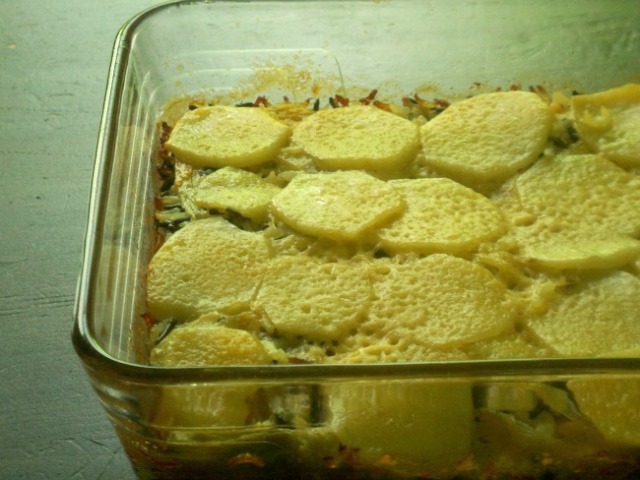
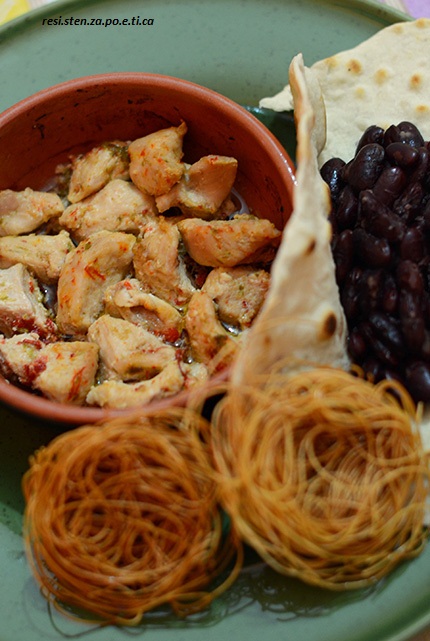
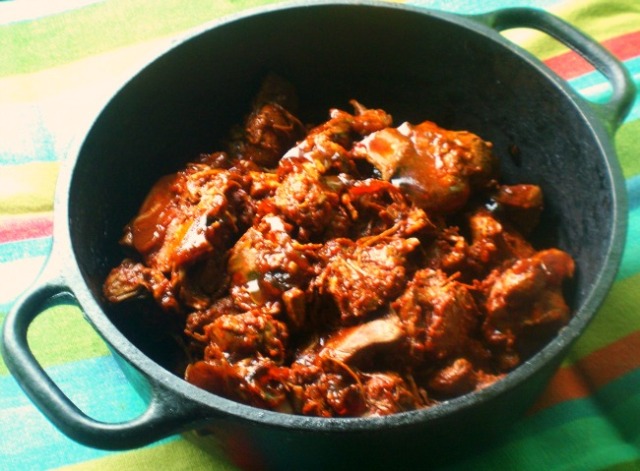

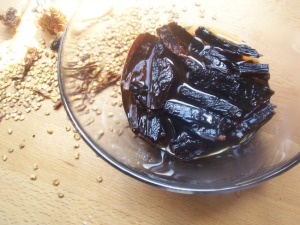
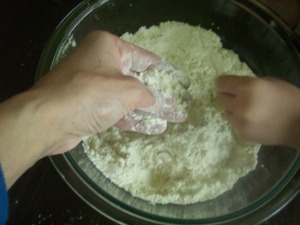
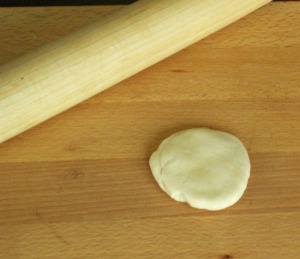

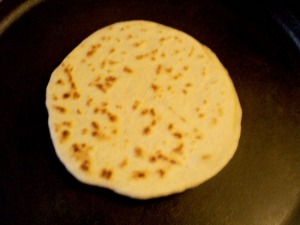






 with 4-3/4″ heels while baking this cake. I am sorry I could not comply.
with 4-3/4″ heels while baking this cake. I am sorry I could not comply.
